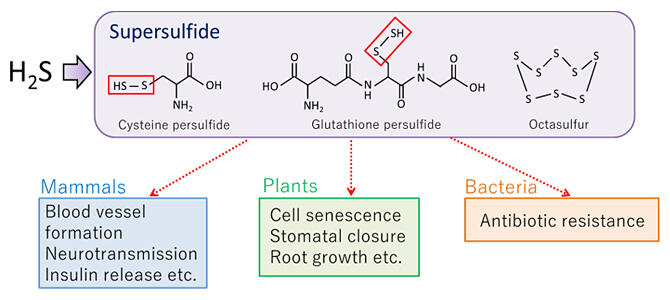Hydrogen sulfide, which is known as a poison, has been revealed to be involved in the regulation of various physiological functions, acting as a "a double‐edged sword." In these physiological functions, 'supersulfide molecules,' in which hydrogen sulfide is activated in various forms, act as signalling factors, but the elementary processes from their metabolism to the regulatory system are not well understood.
A research group led by Research Associate Takayuki Shimizu and Professor Tatsuru Masuda of the Graduate School of Arts and Sciences, the University of Tokyo, Professor Takaaki Akaike of the School of Medicine, Tohoku University, Associate Professor Shinji Masuda of the Department of Life Science and Technology, Tokyo Institute of Technology, and postdoctoral researcher Daiana Capdevila of Indiana University in the United States, has identified how supersulfide molecules that control physiological activities are produced and involved in physiological regulation. The findings are expected to lead to the development of unique therapies for physiological diseases involving supersulfide molecules. The group's research was published in PNAS Nexus.

Provided by the University of Tokyo
The research group focused on enzymes related to the metabolism of supersulfide molecules, which are regulated by the supersulfide molecule‐responsive transcription factor SqrR previously identified by Professor Shimizu and scrutinised the effects of supersulfide metabolism on SqrR‐dependent transcriptional regulation.
SqrR changes its activity by undergoing polysulfide modification from supersulfide molecules. In order to identify the supersulfide molecular metabolising enzymes involved in regulating SqrR activity, the researchers generated respective strains deficient in several candidate enzyme genes and analyzed the transcriptional activity of SqrR. They were able to identify two enzymes with sulphur transfer activity.
One enzyme is the hydrogen sulfide oxidase SQR, known to be a major supersulfide molecular metabolising enzyme and found to be necessary for maintaining SqrR‐dependent signalling. The other is a type of sulphurtransferase called rhodanese, which was suggested to contribute to the attenuation of SqrR‐dependent signalling.
The enzymatic activity of each was measured and SQR showed activity for the synthesis of glutathione supersulfide (GSSH) and cysteine persulfide (CysSSH), a type of supersulfide molecule. On the other hand, although rhodanese showed sulphur transfer activity, it is not known what sulphur is actually transferred where. As such, the researchers analyzed the intracellular dynamics of supersulfide molecules, focusing on SQR, and found that SQR is involved in the maintenance of SqrR‐dependent signalling by contributing to the supply of supersulfide molecules to maintain the polysulfide modification of SqrR.
To determine the type of supersulfide molecule supplied from SQR to SqrR, the group tested which supersulfide molecule would restore the SqrR‐dependent signalling abnormality to normal in the sqr gene deletion strain. They found that treatment of cells with CysSSH restored the effects of sqr gene deletion. Furthermore, SqrR was found to be more reactive towards CysSSH. This showed that SqrR may preferentially detect CysSSH produced by SQR.
These results indicate that the supply of CysSSH and other supersulfide molecules by SQR leads to the sustained regulation of SqrR activity.
The identification of key relationships between hydrogen sulfide/transulphur molecular metabolism and its regulatory mechanisms in this study is expected to lead to the development of completely new approaches and therapies for various hydrogen sulfide‐associated diseases. For example, it has been suggested that in the brain disorder schizophrenia, high levels of hydrogen sulfide in the brain are caused by the accumulation of polysulfide‐modified proteins. This indicates the possibility that the progression of the disease could be regulated by controlling hydrogen sulfide and supersulfide molecular metabolism.
Journal Information
Publication: PNAS Nexus
Title: Polysulfide metabolizing enzymes influence SqrR‐mediated sulfide‐induced transcription by impacting intracellular polysulfide dynamics
DOI: 10.1093/pnasnexus/pgad048
This article has been translated by JST with permission from The Science News Ltd. (https://sci-news.co.jp/). Unauthorized reproduction of the article and photographs is prohibited.




